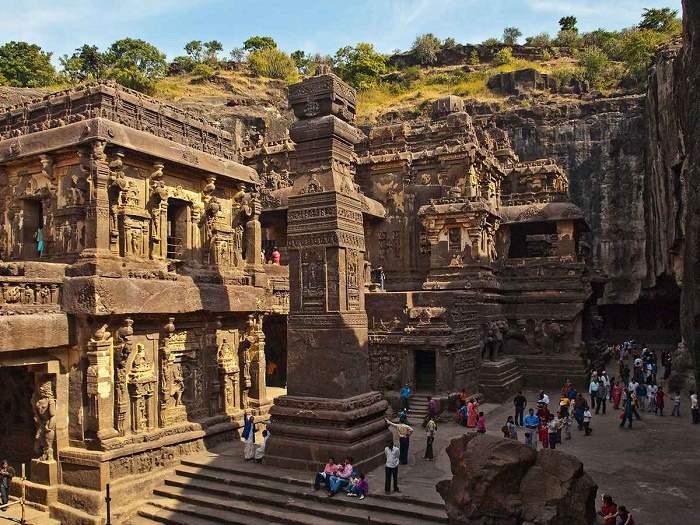
Image Credit: historydiscussion.net
The cave architecture in India is believed to have begun during the ancient time. These caves were used by Buddhist and Jain monks as places of worship and residence. Initially the caves were excavated in the western India. Some examples of this type of cave structure are Chaityas and Viharas of Buddhists. The great cave at Karle is also one such example, where great Chaityas and Viharas were excavated by hewing out rocks.
History & Origin of Cave Architecture
Caves in India have been regarded with reverence since time immemorial. The most primitive caves were the natural ones that were used for different reasons by natives of such areas as places of worship and shelters. Facts supported by data indicate employment and modifications of such caves since the Mesolithic period (6000 BC). Rock-cut designs carved on overhanging rocks form the early examples of architectural craftsmanship of human being on such structures. The arrival of Buddhist missionaries saw use of such natural caves as Varshavasa - that is places of dwelling during rainy season - and also as temples thus enabling them to lead a monastic life in accordance with the aesthetic nature of Buddhism.
Caves excavated out of colossal rocks gradually evolved because of their durability in comparison to other construction material such as wood and with time these structures became more enhanced and richer architecturally. The western Deccan region saw initial excavation of caves. The region has the early cave temples predominantly Buddhist shrines and monasteries that trace back between 100 BC and 170 AD. Many Jain cave basadi that is shrines and temples also form early example of rock cut architecture. The Barabar caves located in the Jehanabad district in the state of Bihar, India, are the oldest surviving caves in India showcasing rock-cut architecture. Rock-cut Hindu and Buddhist sculptures can be seen in these caves many of which dates back to around the 3rd century BC during the reign of the Maurya Empire (322–185 BCE). Some of the other earliest cave temples reflecting cave architecture are situated in the state of Maharashtra, India, including the 2nd century BC Bhaja Caves, the 1st century BC Bedse or Bedsa Caves, the Karla or Karle Caves dating back between 2nd century BC to 5th century AD, the 1st century BCE to 10th century CE developed Kanheri Caves and some of the Ajanta Caves tracing back between 2nd century BCE to around 480 or 650 CE.
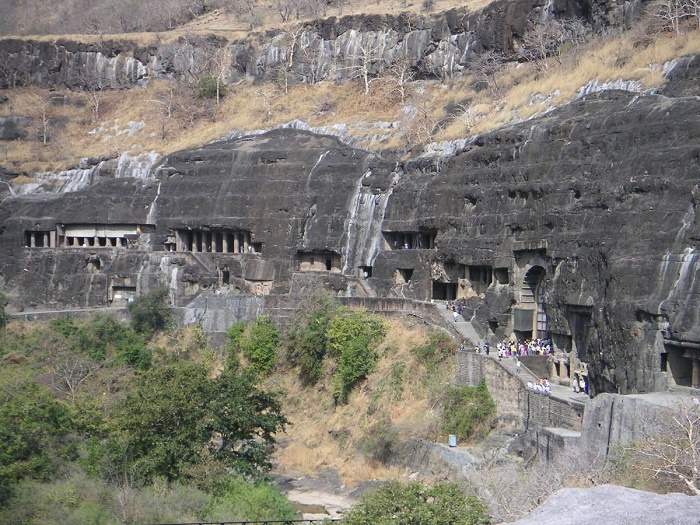
Types of Caves
Caves in India are usually associated with three different religions, namely Buddhism, Hinduism, and Jainism and reflect architectural variance in accordance with respective religions.
Buddhist Caves
Some of the finest examples of cave architecture can be found in the ancient Buddhist caves. The greater chunk of around 1200 surviving cave temples is Buddhist. The topography of the Western Ghats including the deep ravines, the sharp rocky exposures and horizontal basalt hill tops naturally drew the Buddhist monks to the region where they employed the caves as shelters and shrines. From 200 BCE to 650 AD the Buddhist monks kept on occupying the earliest Kanheri Caves situated inside the forests of the ‘Sanjay Gandhi National Park’ in Maharashtra, India, that were excavated out of a huge basaltic rock outcropping during the 1st and 2nd centuries B.C. as also the earliest Ajanta caves dating back to the 2nd century BCE. The earliest caves comprising of cave temples that are associated with Buddhism include the Karla Caves, the Kanheri Caves, the Bhaja Caves, the Bedsa Caves and the Ajanta Caves.
Ideology of Buddhism encourages association with trade and commerce and early involvement of the Buddhists with traders probably influenced them to locate their monastic establishments in close proximity to major trade routes. All Buddhist caves are thus located near important trade routes and remained stopovers for many travelling traders. Commissioned by some of these wealthy traders the interiors of the caves gradually became more enhanced and elaborate. These included sectionalising areas for specific purposes like the viharas and chaityas and embellishing the areas with fine carvings, reliefs and paintings. Some caves also included elaborate facades, arches and pillars. The Buddhist chaityas and viharas stand as examples of early cave structures. While the viharas were residential areas of the monks, the congregational worship was conducted in the cave shrines known as chaityas. A pillared circular chamber in the garbhagriha hewn out of rock enabled one to circumambulate around the stupa.
Buddhist architecture saw a second phase that started in the 5th century AD. The most prominent aspect of architectural design that emerged during this period was introduction of the image of Lord Buddha. Huge statues of Lord Buddha in various postures as also Jataka stories and deities associated with Buddhism in the form of paintings and carvings found place on the stupas. Sculptures associated with Buddhism were also introduced in the viharas.
Hindu Caves
The Hindu caves that are located at different places across India are sort of extensions of Buddhist cave architecture with of course certain alterations in architecture and design suiting the Hindu customs and traditions. The phase of excavation of these caves is from 4th century AD to 8th century AD. Themes from great Hindu epics like the Ramayana and the Mahabharata are depicted in the structures. The most prominent features of Hindu cave architecture are the presence of mandapa and ratha (chariot) that developed during the Dravidian period. While the mandapa hewn out of a rock is a columned hall having two or more compartments meant for the deity, the ratha is a shrine chiselled out of a monolithic rock.
Jain Caves
The Jain caves located in different sites across the Indian subcontinent marked the end of cave architecture. Although it is difficult to trace the earliest phase of Jain cave architecture, it is generally considered to be between 6th century AD and 12th century AD. The highly embellished sculptures of these caves illustrate the tales of Tirthankaras of Jain Pantheon. Elaborately painted ceilings are found in some Jain caves like the ones in Ellora in Maharashtra and Sittanavasal in Tamil Nadu.
Major Caves in India
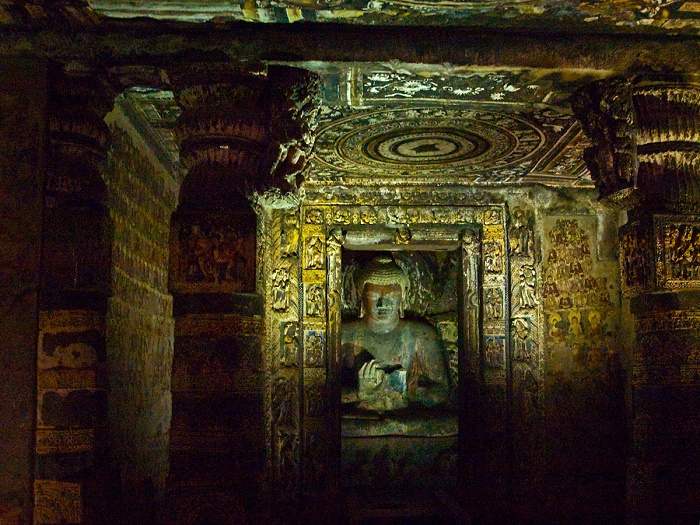
Ellora Caves
Ellora Caves, a UNESCO World Heritage Site, located in the Marathawada region of the state of Maharashtra, India, stand among the largest rock-cut caves around the globe. Marked as a protected monument under the ‘Archaeological Survey of India’, this site has more than 100 caves comprising of monasteries and temples with 34 of them open to public. It showcases Buddhism, Hinduism and Jainism art and architecture through the structures dating back to a period from 600 CE to 1000 CE, thus also reflecting religious harmony that prevailed in India in those times. The structures at the site were constructed by different Hindu dynasties; for instance many Jain caves were built by the Yadav dynasty and several Buddhist and Hindu caves were excavated by the Rashtrakuta rulers. The caves were hewn out of volcanic basalt cliff rock in the Charanandri hills with caves 1 to 12 being Buddhist, 13 to 29 being Hindu and 30 to 34 being Jain caves. Deities and mythological depictions that were in vogue in 1st millennium CE as also monasteries of each religion are seen in the site. The location remained a significant commercial spot in ancient India and was employed by Buddhist monks as monasteries; prayers were conducted in the cave temples while the visiting pilgrims took rest.
One of the most remarkable and imposing cave temples of India is Cave 16 of Ellora, the world’s largest monolithic rock excavation in the shape of a chariot called the Kailasha temple. Dedicated to Lord Shiva this temple commissioned by King Krishna I in the 8th century was built for over 100 years and exhibits deities and mythologies from Shaktism and Vaishnanism with the relief panels illustrating the two great Hindu Epics.
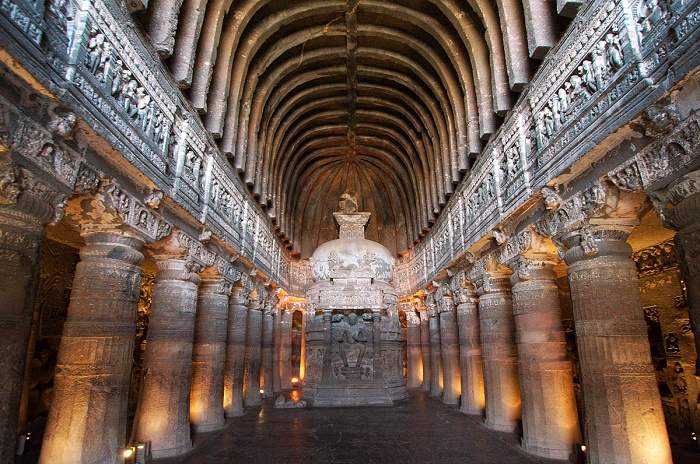
Ajanta Caves
Ajanta Caves are another UNESCO World Heritage Site famous for ancient Buddhist paintings. Ajanta caves are located in the Aurangabad district of the state of Maharashtra, India. Comprising of 29 Buddhist cave monuments, excavated out of rocks, tracing back to the 2nd century BCE to around 480 or 650 CE, the site presents rock-cut sculptures and paintings of utmost brilliance. Ancient Buddhist monasteries (viharas) and worship halls (chaityas) find place at the site. The caves portray fine paintings illustrating Lord Buddha’s previous lives and rebirth, representations from the Jataka tales and sculptures depicting Buddhist deities. Particularly the wall paintings of caves 1, 2, 16 and 17 form the largest body of ancient wall paintings that still exist in India. Textual data indicate that the monks employed this site as shelters during rainy season while the pilgrims and merchants of ancient India used it as a resting place. This site is presently marked as a protected one under the ‘Archaeological Survey of India’.
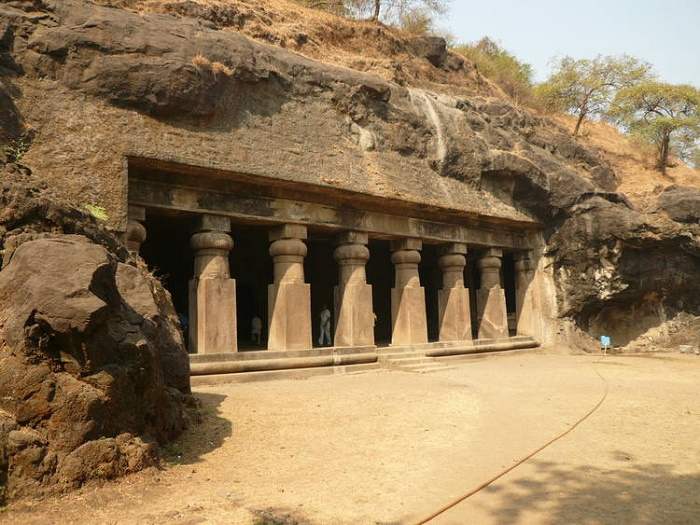
Elephanta Caves
Situated on the Elephanta Island near Mumbai city in the state of Maharashtra, India, this site comprises of five Hindu caves and two Buddhist caves that trace back to a period between 5th century and 8th century and excavated out of solid basalt rock. The Hindu caves of the site are dedicated to Lord Shiva and rock-cut sculptures of these caves represent the Shaiva Hindu sect. Cave 1 also referred as the Great Cave of Elephanta is the most imposing cave of this site which is famous for its remarkable sculptures that illustrate the gradually developed Brahmanical rock-cut architecture. The site is presently maintained by the Archaeological Survey of India and is also marked as a UNESCO World Heritage Site.
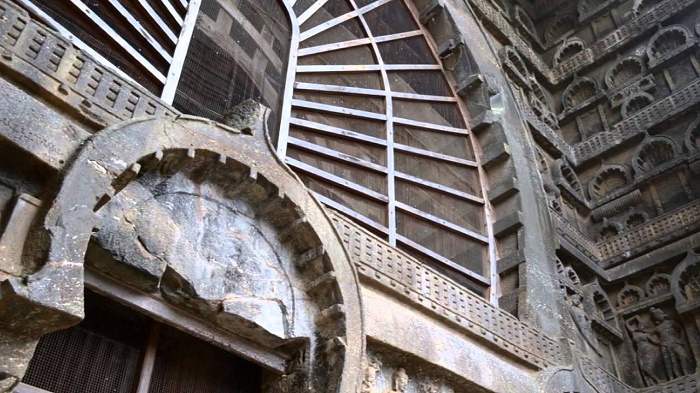
Karla Caves
The Karla Caves also referred as Karla Cells or Karle Caves situated in Karli, in the state of Maharashtra, India, comprise of age-old Buddhist cave shrines excavated out of rocks. These structures trace back to a period from 2nd century BC to 5th century AD with the earliest one considered to be hewn in 160 BC. The main cave of the site houses one of the largest rock-cut chaityas in India that is 45 m in length and 14 m in height. The chaitya or prayer hall is adorned with several vibrant sculptures including that of figures of males, females, lions and elephants among others. The arched entrances and vaulted interiors are the distinct features of the caves of this site which is presently marked as a protected monument under the ‘Archaeological Survey of India’.
Badami Caves
The Badami caves situated in the town of Badami in Karnataka, India, houses Hindu, Jain and presumably Buddhist cave temples. These temples represent Indian rock-cut architecture, particularly a temple building architectural style that developed during the 5th to 8th centuries known as the Badami-Chalukya architecture. This site is representative of earliest examples of Hindu temples. The monuments are highly decorated with finely etched sculptures, elaborate pillars, carved ceiling panels and ornate brackets. Vibrant sculptures depicting Hindu themes are found in the Hindu cave temples like the sculpture of Nataraja dancing Tandava in Cave 1 and that of Trivikrama in Cave 2. The most remarkably carved cave in the site is Cave 3, the largest in the complex. It showcases mythological representations associated with Lord Vishnu.
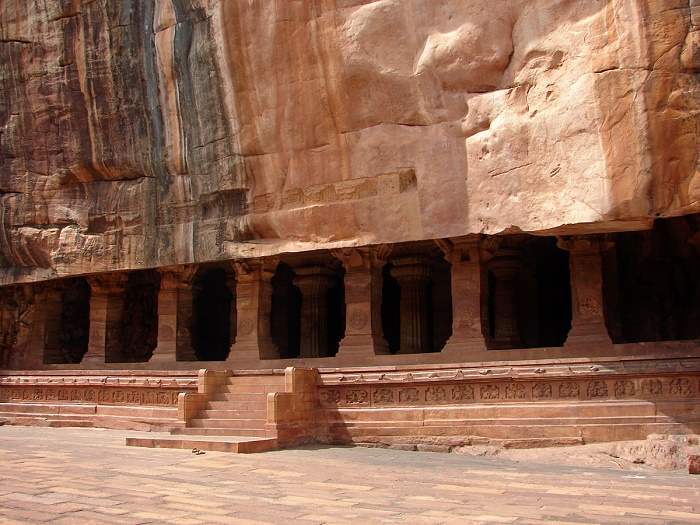
Significance of Cave Architecture
These caves of ancient and medieval ages give us a glance of different architectural styles of different periods and religions. The relics, motifs, murals and sculptures of the caves not only enlighten us with a lot of information of those ancient times giving us an impression of various traditions, customs and lifestyles followed by the inhabitants but also illustrate considerable accomplishment with regard to structural engineering and artistry of those times thus attracting thousands of tourists and architectural enthusiasts round the year.



